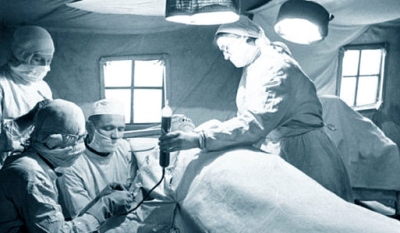Breast operation in 1831, without anaesthetic and with low igenic precaution to avoid infections
The birth of modern plastic surgery….
Two years later, the 1818 was running, the German surgeon Carl Von Graefe, considered the best surgeon in Europe and the father of modern plastic surgery, published “Rhinoplastik”: he there mentioned 55 rhynoplastic operations, but also measures to operate Blepharoplasty (eyelid plastic) and palatoplastica, so as to be considered the father of modern plastic surgery.
But only his successor made the techniques more tolerable thanks to the introduction of anesthesia and the nose operation in two steps to improve its appearance.
For the complete reconstruction of the nose the bone issue was a real problem: the answer goes back to 1892 when Robert Weir used the duck sternum, and coined for the first time the word “rhynomania”, the research of pathological perfection by the patients. “There is no doubt that this behavior persists today and iit s still one of the most important problems of aesthetic plastic surgery ‘.
But the first aesthetic operation is dated to the end of the 19th century thanks to John Orlando Roe, who made the first rhynoplastic operation.
….and the aesthetic one: the important is the beauty
Until the end of the century 19mo plastic surgery was almost exclusively reconstructive and of little value. Then the first world war changed all, thanks to military plastic surgery which was used to correct many trauma to the head reported in battle permitted to improve the discipline, particularly with regard to maxillofacial surgery. In plastic surgery military centers injuries of heads and necks were repaired and if before the first great war masks were used to cover the most terrible wounds after that, disfigured faces would have been repaired by surgeons.
Between 1920 and 1940 plastic surgery was also accepted in the university.
Improvements of anesthesia, use of transfusions, sulphonamides and penicillin permitted to control infections, reduce the rate of mortality and brought more morbidity to the procedures during the war. In some centers the plastic surgical mortality was zero. In addition, amputation in the Second World War was used less than in previous conflicts. In this period we learned to use the lieaco bone for facial bones reconstruction.
And the breast grows.
At the end of the 19th century surgery began to increase breasts with injections of synthetic material. In 1899 they tried with paraffin, then with beeswax, vegetable oils and other crap, until starting from 1960 when this practice was prohibited for damages caused to patients. It then went to implantable protheses: the first were ivory or glass, but those were abandoned because the breas did not seem natural. Then it was the turn of sponge mats, as the Ivalon, which could be modeled to give a more natural appearance to breast, but by the time they got distorted or mor hard. The modern facilities, silicone-based, began in 1963.
Liposuction is the most recent: the technique of sucking fat with a cannula was invented from Ithe talian Arpad Fisher, and developed in 1987 by dermatologist Jeffrey Klein with a new technique which allowed the removal of a greater volume of fat, but with less loss of blood.



Leave a comment